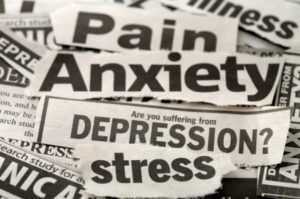Survival depends on the speed of noticing and responding to threats to our safety. In a depressed brain, the parts of the brain that are scanning for danger and responding to it are overly active. Perceiving threat comes too easily. There are several factors about this necessary and natural biological response that may contribute to depression.
- The response time is one such factor. Humans are biologically geared to respond to threat with a physical response to it. Without thought or decision, the brain/body makes possible necessary, immediate action when a threat, or stressor, occurs. Regardless of the level of overt danger, when a person feels a threat, the body responds immediately with arousal in the nervous system, intensifying heart rate, respiration rate, and blood pressure to allow for rapid physical activity. This response is proportional to the threat and ends when the threat is gone. A person also gets a release of energy, the activity of the stress response system, needed to fuel the rapid physical activity. These responses are lifesaving when threats to safety occur – but they are also an underlying factor in developing depression when they are overly active. Some people are born with brain structure that commits too many brain cells to scanning for danger, making the threat response too active.
- The intensity of the sympathetic response may be too great, meaning that the level of arousal and the way it triggers stress response is excessive proportional to the threat. This too can be genetic, or it may be an outcome of early childhood adversity causing high arousal to even smaller threats. It is also important to note that traumatic experience often results in hypervigilant attention to the environment and also a biological tendency to overreact to reminders of the trauma.
- Another aspect of how the threat response system can contribute to depression is how hard it may be to calm the stress response or the nervous system arousal. When these two systems that govern response to stressors are insufficiently supplied with the neurochemicals that bring them back to homeostasis or that buffer brain structures from the impact of the arousal, a person may be negatively affected by the very systems that should otherwise be protective. Unable to calm down quickly enough, the strong and persistent arousal of the nervous system and the stress response system is damaging in several ways. One theory of depression is that the inflammation throughout the body will ultimately cause many kinds of physical and emotional outcomes, not the least of which is depression.
The threat in a modern world may not be the overt danger that human systems developed to cope with stress but rather any situation that calls for a response, even when the demand for physical energy is unnecessary. For example, the stressor may be a situation that is not unexpected or dangerous. It could be a boss who makes a demand for overtime hours when you want to be home with your family or a child who is sick and keeping you awake at night. Those may be temporary and insignificant in general, but when they are ongoing or when they are too frequent then the stress system becomes antagonistic to health.
Over-activation of the nervous and stress response systems ultimately exhaust the brain/body. You can help yourself be less affected by stress. A person may, by genetic predisposition, respond too intensely to a normal level of threat or ongoing life stress may exhaust the supply of energy and create distress. Since so many of us live lives that are filled with stressors that are not the life-death-get-up-and-run variety, we would be well advised to learn the means to diminish stress. While each person must apply these guidelines to his or her own situation, the outline is simple:
- If at all possible, eliminate your stressor. Deciding to change is often the hardest thing people do: Can you stop trying to do something that is just too difficult, that you do not have the capacity for? Can you walk away from things that you cannot control and then manage your guilt for not trying? You might need the perspective of an outside observer to help you figure this out.
- Manage your time or manage your environment. Learn to make good use of lists to create job tasks by prioritizing or stop saying yes to demands for your help when you have too much to do. And learn the skills to organize the environment. Trying up may be life-changing indeed for some, but the diminished stress of an orderly environment can be life-saving, especially when you combine it with using calendars, reminders, and lists to manage time.
- Manage your attitude. Lightening up and finding your sense of humor can go a long way toward lowering your stress level. So, can becoming more sanguine about life experience. Learn to tell the difference between what is urgent is important and then learn that urgent may sometimes just be ignored.
- Learn to relax. This is not just about ‘vegging out in front of a program or video game. It is about loosening those muscles and calming the mind. Whether you do best with brief and frequent breaks every day or relax with longer periods of muscle relaxation, either way, it is a relief to your brain/body to relax. People who develop apps know this, so, it turns out there are countless options to use technology to guide your relaxation practice. You may be one of those who relaxes via vigorous exercise. But relax. Daily.
When you have addressed these four means to diminish the intensity of your response to ordinary life stress, then you will be on your way to eliminating depression too.
By Margaret Wehrenberg, Psy.D.
Dr. Wehnrenberg is a coach and therapist, an author, and an international trainer and speaker on topics related to psychotherapy for anxiety and depression, stress management and optimizing anxiety for achievement. She is a practicing psychologist, coaching for anxiety management and providing psychotherapy for anxiety and depression disorders. She has been a trainer of therapists for 25 years, and she is a sought-after speaker for continuing education seminars, consistently getting the highest ratings from participants for her dynamic style and high-quality content. Her individualized coaching for panic, worry and social anxiety has helped professionals from entrepreneurs to corporate executives, from sales personnel to IT specialists.
Margaret is a frequent contributor to the award-winning Psychotherapy Networker magazine and has produced Relaxation for Tension and Worry, an audio file for breathing, muscle relaxation, and imagery to relax. Audio and DVD versions of her training are available for obtaining CEU’s. She has seven books on topics of anxiety and depression published by W.W. Norton, a and a workbook, Stress Solutions, published by PESI. Check out her website MargaretWehrenberg.com.












Interesting and informative post! Thank you! I’m a sole practitioner and generally manage stress very well by making trips to the gym and to the running trails a priority in my week. I’ve done this since high school and here I am now, having practiced law for 34 years. Sometimes that is not enough, however. Lately I’ve found that I need to learn not to take on more than one high-maintenance client at a time. Right now, I’m handling a bitter divorce; a contested probate where the parties, who are brother and sister, absolutely detest each other and who would refuse to agree, on principle, that the sky is up; and a legal situation in my extended family that is extremely stressful. The stress of all this has driven me to this website!